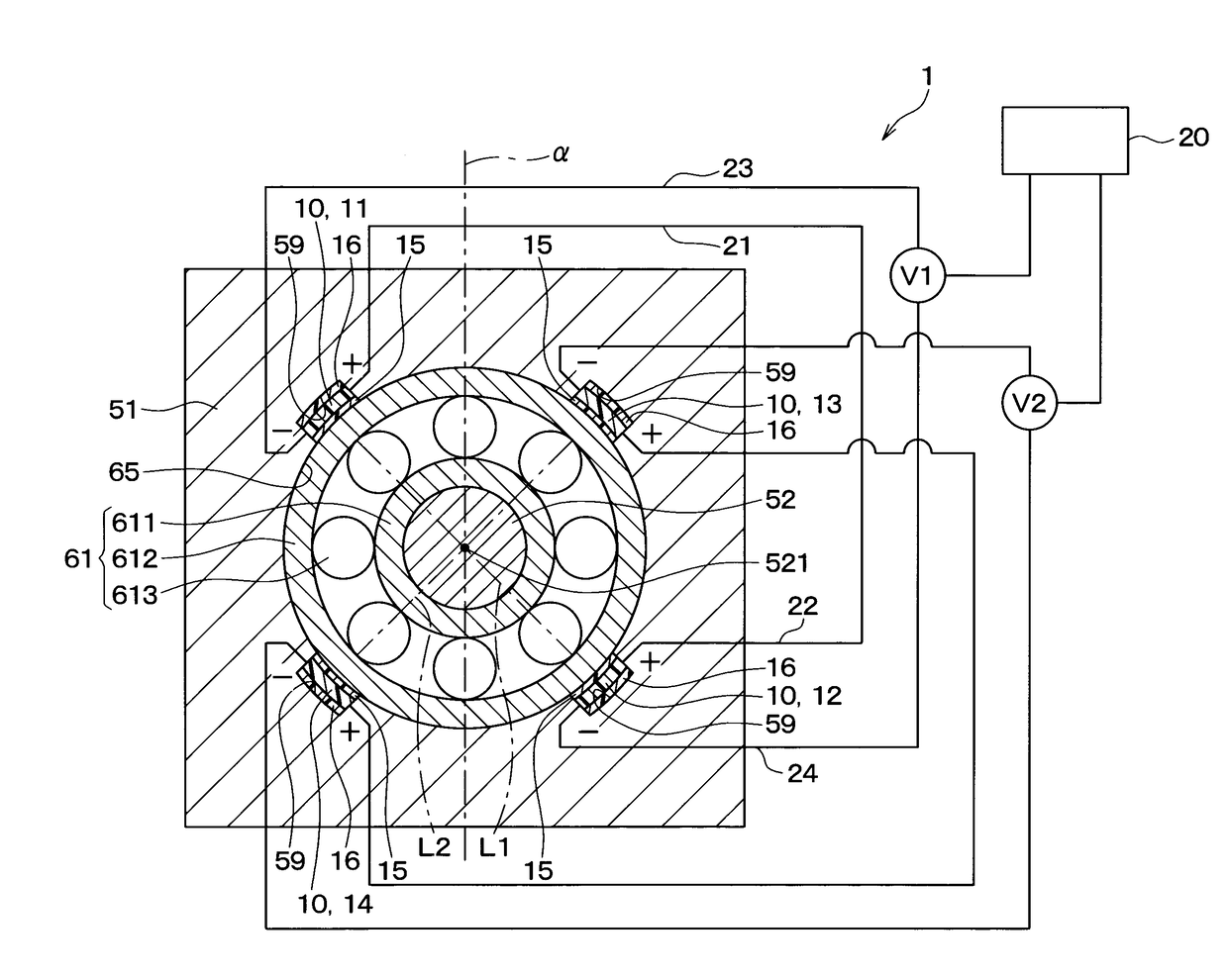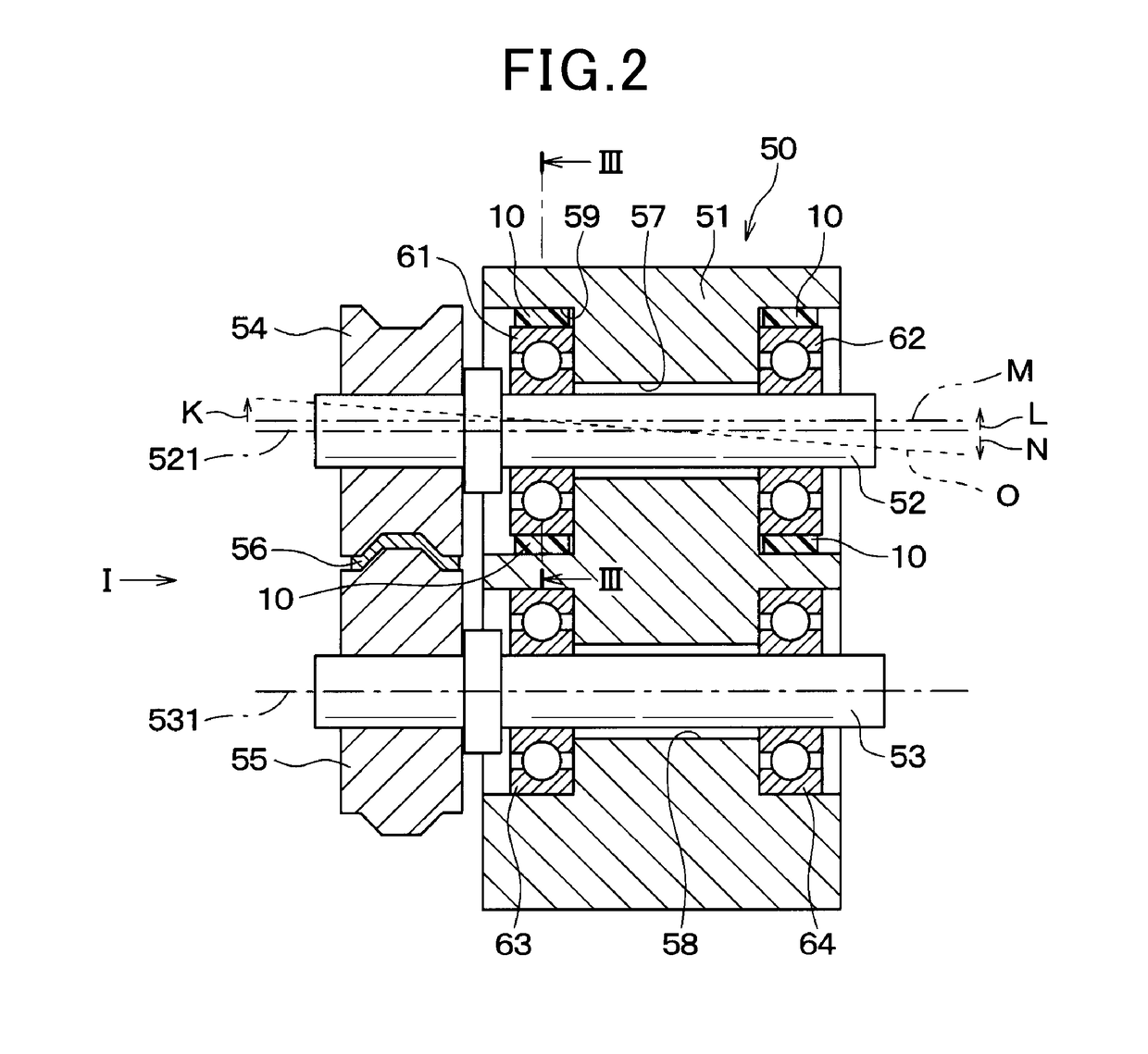Monitoring device
a technology of monitoring device and load cell, which is applied in the direction of measuring device, heat measurement, instruments, etc., can solve the problems of reducing the operation rate, increasing the workload of inspection, and difficult wiring of attaching load cells to shafts, so as to increase the amount of heat flowing from the bearing to the housing
- Summary
- Abstract
- Description
- Claims
- Application Information
AI Technical Summary
Benefits of technology
Problems solved by technology
Method used
Image
Examples
first embodiment
[0030]A first embodiment of a monitoring device will be described. As shown in FIGS. 1 to 3, a monitoring device 1 of this embodiment is attached to a forming machine 50 which is the device to be monitored. The monitoring device 1 monitors a load applied to a shaft or bearing in the forming machine 50.
[0031]First, the forming machine 50 will be described.
[0032]As shown in FIGS. 1 and 2, the forming machine 50 includes a housing 51, two shafts 52, 53, and two forming rollers 54, 55. The two shafts 52, 53 are provided in the housing 51 such that they can rotate about their axes. Each forming roller 54, 55 is fixed to the corresponding shaft 52, 53 at an end thereof. The shaft 52 and forming roller 54 in FIG. 1 will be hereinafter referred to as a first shaft 52 and first forming roller 54. Additionally, the shaft 53 and forming roller 55 in FIG. 1 will be referred to as a second shaft 53 and second forming roller 55.
[0033]The forming machine 50 passes a strip material serving as a pro...
second embodiment
[0088]The monitoring device 1 of a second embodiment differs from the first embodiment in the method of detecting an abnormality, performed by the detector 20.
[0089]FIG. 8 shows examples of the changes in the first signal V1 and second signal V2 over time when the forming machine 50 is in operation. The horizontal axis in FIG. 8 shows the time that has elapsed since the forming machine 50 started operation. The vertical axis shows voltage.
[0090]In FIG. 8, the solid line P shows the change in the first signal V1. The dashed line Q shows the change in the second signal V2. Here, it is assumed that the first signal V1 becomes a positive voltage signal when the load at one of the ends of the line L1 connecting the first heat flux sensor 11 and second heat flux sensor 12 increases. The first signal V1 becomes a negative voltage signal when the load at the other end of the line L1 connecting the first heat flux sensor 11 and second heat flux sensor 12 increases.
[0091]It is assumed that th...
third embodiment
[0096]The monitoring device 1 of the third embodiment differs from the first embodiment in the way the first to fourth heat flux sensors 11 to 14 are attached to the bearing.
[0097]As shown in FIG. 9, the housing 51 in the forming machine 50 includes threaded holes 66 extending outwards in radial directions of the first bearing 61 (radially outwards) from the inner walls of the recesses 59. Screw members 30 are inserted into the threaded holes 66. Each screw member 30 is engaged with the internal thread formed on the inner wall of the corresponding threaded hole 66. The leading ends of the screw members 30 on the bearing side are in contact with the first to fourth heat flux sensors 11 to 14. The screw members 30 press the heat flux sensors 10 against the outer wall of the first bearing 61. Accordingly, the third embodiment prevents gaps being formed between the outer wall of the first bearing 61 and the heat flux sensors 10.
[0098]The screw members 30 are formed of a material with a ...
PUM
| Property | Measurement | Unit |
|---|---|---|
| heat fluxes | aaaaa | aaaaa |
| thermal electromotive force | aaaaa | aaaaa |
| thermal conductive | aaaaa | aaaaa |
Abstract
Description
Claims
Application Information
 Login to View More
Login to View More - R&D
- Intellectual Property
- Life Sciences
- Materials
- Tech Scout
- Unparalleled Data Quality
- Higher Quality Content
- 60% Fewer Hallucinations
Browse by: Latest US Patents, China's latest patents, Technical Efficacy Thesaurus, Application Domain, Technology Topic, Popular Technical Reports.
© 2025 PatSnap. All rights reserved.Legal|Privacy policy|Modern Slavery Act Transparency Statement|Sitemap|About US| Contact US: help@patsnap.com



